Wednesday, December 26, 2012
Curiosity Rover Report (Dec. 21, 2012): Curiosity's Martian Holiday
My dear readers, I wish this could be a happy time for me to write another report reflecting on Curiosity's work over the holidays instead of posting JPL's video update but I have lost my first ever reader. My Dad, Doctor Bashir Samma, passed away five days ago on what was supposed to be the end of the world. The irony couldn't have been any bitter for me. He'll be sorely missed by me, my mom, my thirteen year old brother, our family and his many grateful patients and colleagues. MY take home message for you this holiday; cherish each other dearly. His message would be; never stop being curious. RIP Dad!
Wednesday, December 19, 2012
Mars in a Minute: How Do Rovers Drive on Mars?
Yet addition to JPL's 'Mars in a Minute' series. This one talks about how the rover is actually driven on Mars. Very simple and informative (subtly wacky at times in fact).
Enjoy!
Sunday, December 16, 2012
Scoping out Yellowknife bay
Curiosity has had a busy week of driving around Yellowknife bay, looking for a nice place drill. That would be yet another mission first and another historical first for interplanetary exploration which, by the way, celebrated its fiftieth anniversary 2 days ago with the flyby of Venus by the American spacecraft Mariner 2. You can check out the Jet Propulsion Lab's awesome video about Mariner 2's adventure. Go check it out here.
Now back to Curiosity, its now sol 129 as of this writing and has traversed more than 600m since landing day. Since leaving that outcrop last week (see this last post) called 'Shaler', Curiosity has ventured deeper into the bay which is actually a depression exposing about a metres worth of Martian layered bedrock. Here's a map of the recent traverses up to sol 123.
 |
| Sol 123 map. The inset shows the excursion at Yellowknife bay in detail (NASA/JPL/UA) |
Right now the rover is parked near a ledge to the North of it's sol 123 position which you can see in the map as a dark, straight line north of the area demarcated by the white box. The ledge is pretty flat and that is one of the factors the team has in mind for a place to drill. It also has to be pretty stable and not collapse under the weight and force of the driller itself. Some information on the unmanned space flight forum (see the sites list to your right for a link to the forum) indicates that we won't be seeing any drilling until after the holidays and and the whole thing may take many more than a month to complete. We can't rush history I guess!
Here is a navigation mosaic showing the view near the Ledge as I'll call it for now:
 |
| Sol 127 navigation view of the Ledge (NASA/JPL/mosaic by me) |
The mosaic shows only part the ledge, its north-eastern part that is. The rest of it can be seen in this 360 degree panorama shot by Curiosity when it was farther away on sol 125:
 |
| Sol 125 navigation panorama. The Ledge is the dark line to the right in the distance where a mound can be seen (NASA/JPL/panorama by me) |
Its always nice to correlate what you see on the ground with high-resolution maps. Sort of adds more depth and regional context to the scene. A colour mosaic was also shot of the future sol 127 site on sol 125:
 |
| Sol 125 colour mosaic with the 34mm focal length (left eye) lens (NASA/JPL/MSSS/mosaic by me) |
Good times! Now here, dear readers, I stop. But I'm leaving you with a surprise this time seeing that the holiday season is almost upon us and I'm feeling jovial myself. While on Google + I found a referral to a web-series (like a TV series except its on the web) that is absolutely brilliant! For all you hard sci-fi lovers, H+: the Digital series is the series for you. Checkout the first episode here. Hurry up, you've got 42 episodes to catch up with (each episode is less than 10 minutes long)! Plus don't forget to follow me on Google + while you're at it by clicking the 'add to circle' button in the upper right column of this page.
Saturday, December 8, 2012
Pages of Natural History
It's now sol 121 midnight at Gale crater and Curiosity has been returning some excellent vistas from its new location besides a layered outcrop.
 |
| Curiosity's current position is marked 'Sol 120 position'. Also marked are recent stops and Yellowknife bay. The red route ends at Rocknest. This view looks southwards (Google) |
Before, Curiosity spent more than two weeks (sol 102 up to 119) at Bell Island, conducting contact studies of the rock with it's APXS instrument.
 |
| Bell Island, sol 117 (NASA/JPL) |
Here is a gorgeous colour mosaic of the scene at Bell Island shot on sol 118 looking towards the south of the rover (towards Mount Sharp).
 |
| View from sol 118 looking south, south west (NASA/JPL/MSSS/mosaic by me) |
Then on sol 120, Curiosity drove towards the cool looking outcrops of layered rocks that you can see to the extreme left in the mosaic above.
 |
| Sol 120 navigation mosaic shows the layered outcrop targeted by the sol's drive (NASA/JPL/mosaic by me) |
Why is the team so interested in layers? These rocks are layered and therefore indicates their sedimentary origins. Each layer represents a period of past environmental conditions, like pages of a book. And each page might reveal a different part of Gale's past. And Curiosity is all about past natural history. Something tells me we're going to be here for a while.
Monday, December 3, 2012
On the scientific process: SAM's findings
Today's press briefing at the American Geophysical Union's Fall meeting in San Francisco was all about the SAM instrument's findings at Rocknest that, despite being not what the popular press had us believe, are nevertheless extremely interesting but before I delve into a summary of the findings, I'd like to reiterate what Grotzinger, the lead scientist for the mission who was on the panel today, said to illustrate for the over excited general public how exactly science works; repeatability is key to your results and that's why even us doctors send patients back to the labs for a second one because we HAVE TO BE ABSOLUTELY SURE about what we are seeing.
 |
| Curiosity has been busy at Rocknest, digging 6 times(NASA/JPL/MSSS) |
In this case what was Curiosity's team trying to verify? Plenty it turns out. SAM has so far done 3 rounds of analysis on the sample and has a lot to show for it. Remember that SAM consists three main instruments, each of which can work on the same sample. These are the 1. Gas Chromatograph (GC), 2. a Tunable Laser Spectrometer (TLS) and 3. the Quadrupole Mass Spectrometer (QMS) which can work together with the Gas Chromatograph or as a stand alone for atmospheric analyses. For a complete SAM lecture go here. All these instruments in SAM help to further chemical analyses on Mars especially with regard to carbon-containing compounds i.e. organics.
In a nutshell, SAM found:
- A variety of gases released after heating the samples to high temperatures and pumping them to the TLS and GC for analysis. Water detected was detected which isn't unusual. The water is chemically locked into the crystal lattice of the sample grains though it was higher than expected. Carbon dioxide was formed and may have come from carbonates.
 |
| (NASA/JPL-Caltech/GSFC) |
- Other gases detected include chlorine and oxygen which brought up the possibility of perchlorate (kind of like your peroxides but with chlorine instead of oxygen; highly oxidizing stuff). Perchlorate were first detected in the northern arctic regions of Mars by the Phoenix lander back in 2008 and some scientists believe that perchlorate may actually be oxidising the organics before we had a chance to detect them in previous missions. These are tentative results however. Sulphur was also found indicating the presence of sulphates or suphides in the soil.
 |
| (NASA/JPL-Caltech/GSFC) |
- There were some 'carbon-containing' compounds detected. Chloromethane (methane molecule containing a chlorine atom) was found in the soil at Rocknest although the team was quick to stress that although the chlorine was decidedly Martian in nativity, the origin of the carbon is an open question and is being investigated further. The panel member for SAM, Paul Mahaffy, said that most likely the carbon in this case is simply Earth-based carbon that happened to be on the rover that recombined with the heated chlorine atoms during the experiment. Hence the team's declaration; no organic compounds have been definitively found at Rocknest. But they'll keep looking.
 |
| (NASA/JPL-Caltech/GSFC) |
- Apart from the question of organics, there was an extremely interesting find of what appears to be high deuterium to hydrogen ratio (deuterium is a heavier variety or 'isotope' for hydrogen). The value is higher than that on Earth which illustrates the purpose of the ratio; its used to determine the extent of planetary atmospheric loss. The more the loss, the higher the ratio because the heavier deuterium is lost at a slower rate than the lighter hydrogen. Remember that Mars' atmosphere lacks proper protection from the solar winds erosive influence unlike on Earth where we have a powerful magnetic field that does just that.
 |
| (NASA/JPL/ASU) |
And that's your update in a nutshell. Stay curious!
Saturday, December 1, 2012
Curiosity Saturday Fiesta
After a weekend of medicine I always like to just be a browser once again and browse the social media channels for bits of news on other learning fronts of life. Today 2 things complemented each other so well on Curiosity's mission so far that I decided to dub this post as your Saturday Curiosity Fiesta. Our first treat is yet another of the Jet Propulsion Lab's awesome video updates on Curiosity's progress this past week.
Here is a Mastcam left eye colour image of the contact science target 'Bell Island' mentioned in the video above.
 |
| Bell Island, sol 112 (NASA/JPL/MSSS) |
Now as I recall I had hoped to write a summary on the workings of the SAM instrument aboard the rover. Considering the recent hullabaloo on the instrument's 'history-making' but 'secret' discovery which turned out to be not so sensational as some of us imagined, this is more than relevant to today's fiesta.
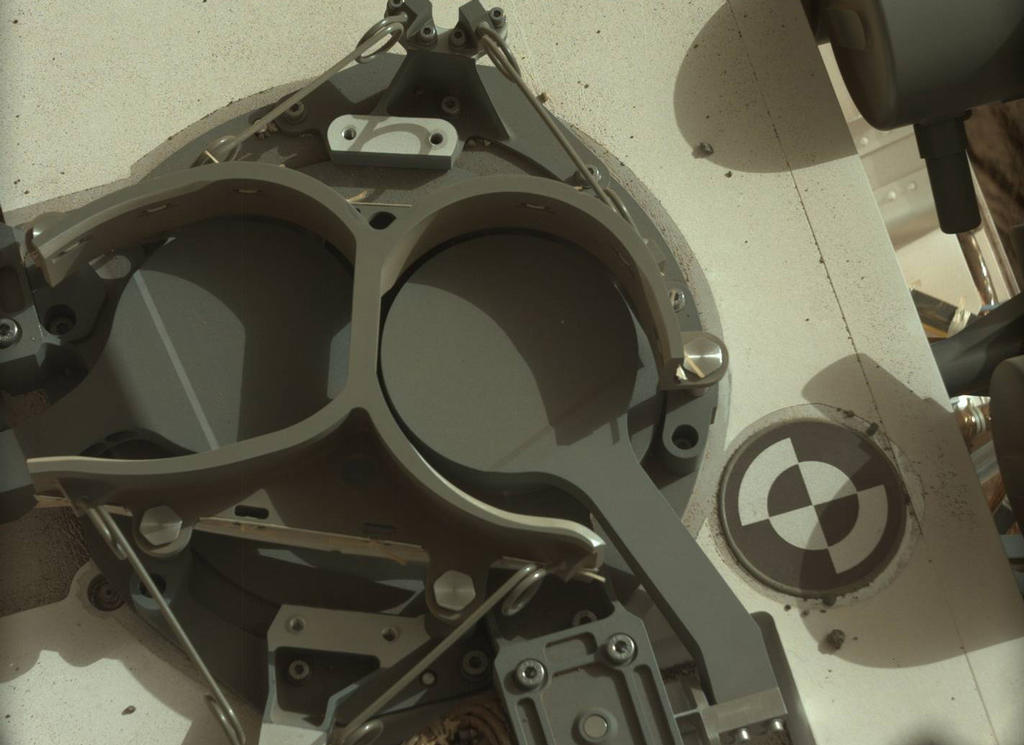 |
| The 2 sample inlets leading into SAM (NASA/JPL/MSSS) |
But Emily Lakdawalla over at the Planetary Society's blog has I think an even better and more thorough account on SAM (its over 4000 words, yikes!). You can read her excellent post here. That's the second Saturday treat.
Don't forget folks that we have an update on the rover's scientific work coming soon from the AGU's Fall meeting in San Francisco on December 3 at 5pm GMT. You'll be able to listen in via ustream. And that's your last treat for today.
Thursday, November 29, 2012
Turn that frown upside down!
 |
| Navigation camera mosaic sol 111 showing Yellowknife bay (NASA/JPL) |
But we shouldn't be too disappointed. After all, Gale is new territory and we are in uncharted waters as far as Mars exploration goes. Mars has an extremely well established tenacity for surprises and with Curiosity's whopping science package we should expect lots of future surprises that will revolutionise our understanding of the red planet and our own world.
Tuesday, November 27, 2012
Time Magazine's Person of the Year
 |
| TIME honoured the protesters last year (Time warner) |
Thursday, November 22, 2012
Dust storm to the South
As I said in a previous post, it's southern spring turning summer and this is when we should expect dust storms to form usually starting from the south. The reason for this is that Mars' orbit is such that it closest to the sun during southern solstice (that is southern summer) than any time of the Martian year. This means more solar energy hits the Martian surface, creating atmospheric instabilities that give birth to storms that may be regional or global in size.
This storm was tracked from the northern hemisphere as it descended south to its current position (up going down in the mosaic above) where it settled and and is now growing. This is so far a regional storm but already the skies are darkening a little at Meridiani planum where Opportunity is and Curiosity is reporting a drop in pressure and elevated night temperatures (the extra dust in the skies traps more heat which elevates temperatures). Curiosity is nuclear-powered and has only to accomodate warmer ambient temperatures than usual but Opportunity is solar-powered and might suffer from a loss of solar power. For an idea of what its like under such storms, see the montage of images below from Opportunity during a global storm in 2007.
 |
| The symbol above is tau and represents atmospheric opacity (Commons/NASA/JPL) |
Now this is all just dust and not sand or anything sind-sized because Mars' atmosphere is too thin to lift these materials in to the air for an extended period of time. But despite that, these storms can do damage to hardware and potentially humans (fine aerosols in the air might cause lung irritation or even cancer) so understanding how to predict when and which regional hiccups can cause global wipe outs would be great. Welcome to Mars folks! We can expect sunny and dry spells interspersed with showers of dust and snow (I'm not kidding, it actually SNOWS on Mars).
Visit the Malin Space Science Systems site for a weather report on the current storm.
Visit the Malin Space Science Systems site for a weather report on the current storm.
Wednesday, November 21, 2012
Animation of Curiosity Rover's First 'Touch and Go'
This animation of Curisotiy's recent 'touch and go' activities was made on the RSVP software which the mission team uses to prepare commands for a day's work before sending them to Mars via NASA's Deep Space Network.
What has Curiosity found?
I guess we're finally there now. Welcome to Glenelg folks!
The rover arrived here after driving 27.2m eastwards since leaving the drift at Rocknest (CHIMRA is still holding a sample from the fifth scooping activity which will be used for analysis whenever its OK to do so). After driving almost 2m last week on Friday, the rover did a 'touch and go' operation on a rock dubbed 'Rocknest 3' the following day where the team commands for a short arm instrument readout for a short while before moving on. In this case they took a 10 minute readout with the APXS instrument before stowing the arm and driving 25.3m until they hit the area you see in the above mosaic. From here on the plan is to select a new target for potential drilling.
While writing this post, I caught a bunch of tweets from different people saying something about a 'discovery for the history books' made by the SAM instrument during its analysis of soil at Rocknest. Already I could feel a tingle of sensationalistic mystery creeping throughout my being. Grotzinger, the mission's chief scientist based in Caltech, Pasadena said that its (the discovery) 'gonna be one for the history books' but we'll have to wait while they recheck their measurements before they announce what exactly was all the hubbub for. According to SPACE.com's 20/11/2012 report:
The rover team won't be ready to announce just what SAM found for several weeks, NPR reported, as scientists want to check and double-check the results. Indeed, Grotzinger confirmed to SPACE.com that the news will come out at the fall meeting of the American Geophysical Union, which takes place Dec. 3-7 in San Francisco.The American Geophysical Union (AGU) is where all the action will be as far as this piece of Martian mystery is concerned though you can be assured that whatever it might be it might very well be interesting only to the geologists. Unless they've found methane... but don't count on it. Stay curious!
Monday, November 19, 2012
Moving On
Curiosity has finally completed her activities at the drift and has finished the first day of her 100th sol on Mars with a bump forward by a metre or so. That leaves her only a few tens of metres before she hits Glenelg, a treasure trove of sedimentary layers for her mission team to drill into! There lie a few pages of precious geological revelations folks. Stay tuned!
| Glenelg's layers as seen by the navigation cameras, sol 100 (NASA/JPL) |
Saturday, November 17, 2012
Whirlwinds and Radiation
Thanks to our blooming power company, writing this report for yesterday's telecon proved to be a challenge in and of its itself. It was all air and radiation yesterday as the speakers talked about what the data from Curiosity's weather and radiation-measuring instruments so far show.
The Dynamic Albedo of Neutrons (DAN) and the Rover Environmental Monitoring Station (REM) instruments showed nothing out of the ordinary in terms of a discovery although 2 strange things amid the graphs stand out.
Measurements from REM show pressure patterns typical of a southern spring equinox turning into summer. As that happens we should see a gradual increase in average daily pressure. This happens because the southern polar cap, which contains carbon dioxide locked away as 'dry ice' plus water ice, will release its bulk of dry ice gas back into the atmosphere as gas (i.e. sublimation) as summer approaches (this process leaves behind an ice cap richer in water ice as that cannot melt nor vaporise under current Martian conditions). This has been noticed together with a daily rise and fall of pressure which is caused by daily heating of the atmosphere during the day (which lowers the pressure) and cooling at night (which raises the pressure). These daily planetary transitions of pressure is called a 'thermal tide' (see the diagram below).
Things get interesting when we get to the wind data which shows two things. The first, more dramatic, find is a period of time when the direction of wind started to change in a sudden manner. These changes corresponded to significant dips in pressure by about 1 to 2 pascals. This indicates a small, low pressure with high speed winds system passed over the rover at the time i.e. a whirlwind or dust devil which are common on Mars as well as Earth. Curiosity didn't image these events maybe because they simply missed them (there were 2 events on sol 75 of the mission) or, more likely, they weren't carrying enough dust to make themselves visible. This would agree with orbital images which can spot any signs of a previous episode of dust-moving-whirlwinds. None have been seen in Gale crater so far. It should be noted that despite the image below, Mars' dust devils have not enough power to blow over or damage the rover in any way because of the comparatively thinner air density.
Second, the speakers at the telecon mentioned about the wind patterns in the area. Winds were simpler to understand in previous missions because their areas of investigation were mostly flat areas of land. But here the topography is wild and that makes the wind much harder to understand. The team expected to get winds directed towards them from a north-south direction, directed so by the slopes of mount Sharp that lies just south of the rover. Instead REM is giving directions from the east-west direction, indicating that it might actually be the rim of the crater that is directing the wind. The wind direction is, however, expected to shift to a north-south direction when the rover starts driving up the slope of Sharp. As Claire Newman, the PI of the REM package put it, it would be a big surprise if that didn't happen. Already their computer models are being put to the test which also allows us to test out forecasting methodologies used here here on Earth (a direct return of investment).
Curiously there seems to be some evidence of a general upward trend in the radiation being received by DAN and may signal the existence of a new cycle that the team have yet to elucidate.
And there you have it. SAM has already ingested another sample of Martian regolith and... the power is finally back after 2 whole days! Now I can cool down under the fan!
 |
| REM (NASA/JPL) |
 |
| DAN sits on the side of the rover (NASA/JPL) |
 |
| Thermal tide (NASA/JPL) |
 |
| Dust devil on Earth (Jeff T. Alu, Commons) |
Second, the speakers at the telecon mentioned about the wind patterns in the area. Winds were simpler to understand in previous missions because their areas of investigation were mostly flat areas of land. But here the topography is wild and that makes the wind much harder to understand. The team expected to get winds directed towards them from a north-south direction, directed so by the slopes of mount Sharp that lies just south of the rover. Instead REM is giving directions from the east-west direction, indicating that it might actually be the rim of the crater that is directing the wind. The wind direction is, however, expected to shift to a north-south direction when the rover starts driving up the slope of Sharp. As Claire Newman, the PI of the REM package put it, it would be a big surprise if that didn't happen. Already their computer models are being put to the test which also allows us to test out forecasting methodologies used here here on Earth (a direct return of investment).
Curiously there seems to be some evidence of a general upward trend in the radiation being received by DAN and may signal the existence of a new cycle that the team have yet to elucidate.
 |
| Can you see the trend upwards? (NASA/JPL/SwRI) |
Wednesday, November 14, 2012
Telecon tomorrow
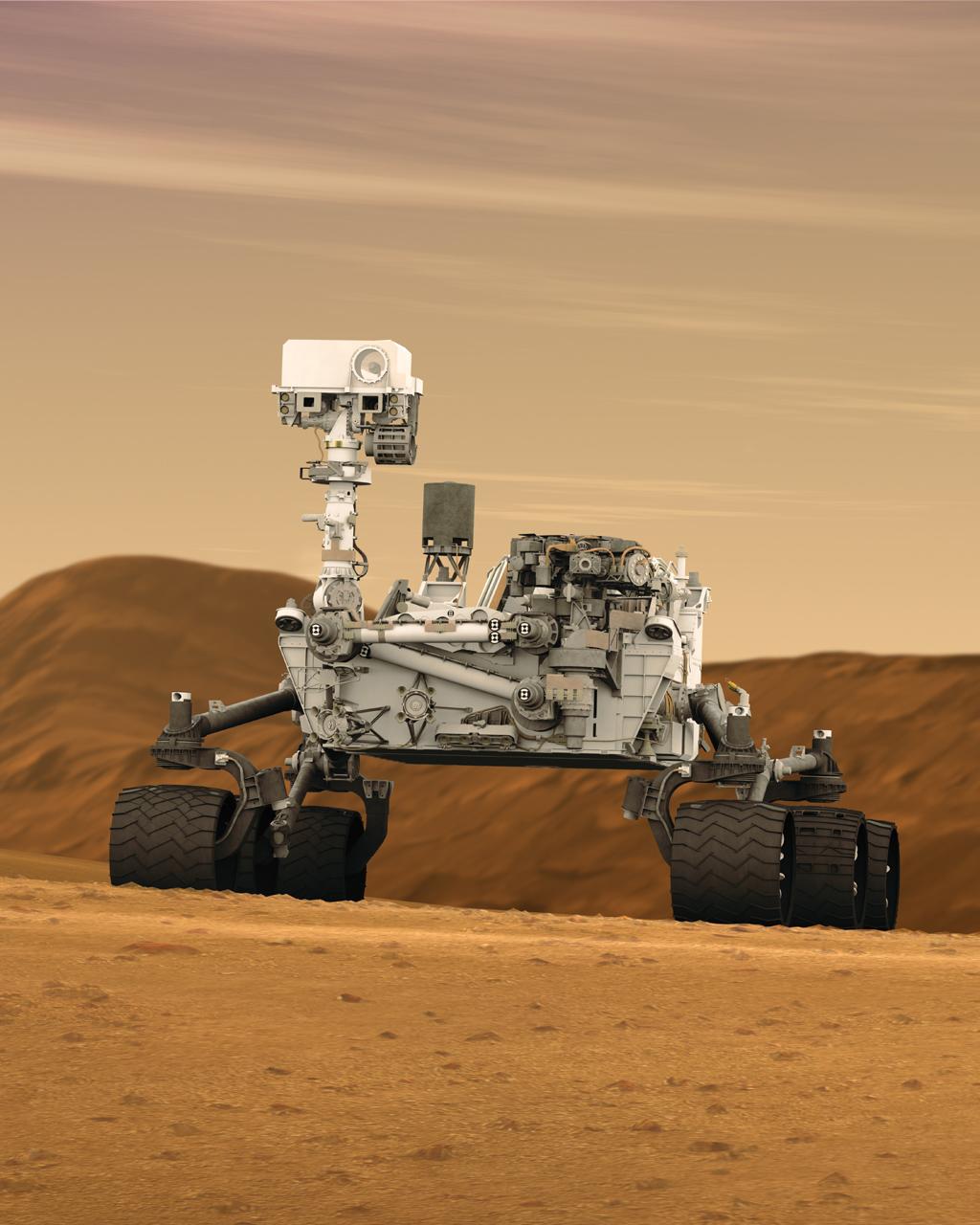 |
| NASA/JPL-Caltech |
I'm not sure if this conference will talk about SAM. We shall see tomorrow.
Monday, November 12, 2012
Fifth scoop for SAM
It's been a busy week but I have finally had some time to check out Curiosity's recent activities. We're now in the post sol 90 portion of the mission where most of the team conduct planning and execution via remote means like phone and the web. It certainly makes things easier for a lot of people I'm sure. It must be something like the difference between an actual university course and an online course, you don't need to leave your life behind and live by a timetable that shifts by forty minutes everyday (because a Martian day is longer than Earth's by that number of minutes).
This week Curiosity has dug into Rocknest for the fifth glorious time and has a sample destined for the Sample Analysis at Mars (SAM). Remember that last time it was the CheMin instrument (see this post) that got the first sample and now here we are with yet another state-of-the-art instrument about to receives its share.
SAM is a really complicated instrument and even more complicated to actually run but in the end the investigators involved would like to acquire high quality data so the instrument demands a lot before sample reception. As Ken Herkenhoff explained in a recent blog entry on the USGS's astrogeology site:
I really find SAM amazing. I loved chemistry a lot back in my highschool days and this is one instrument that will keep me busy while I try to read up on it.
This week Curiosity has dug into Rocknest for the fifth glorious time and has a sample destined for the Sample Analysis at Mars (SAM). Remember that last time it was the CheMin instrument (see this post) that got the first sample and now here we are with yet another state-of-the-art instrument about to receives its share.
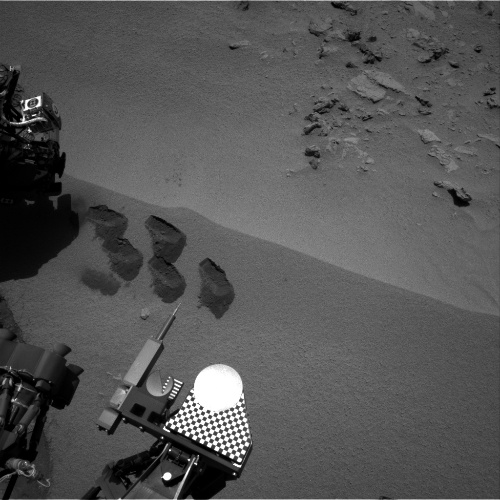 |
| Five little trenches on sol 93's navigation view (NASA/JPL) |
The focus is on preparing SAM for delivery of its first solid sample, which involved a "dry run" that went well and preconditioning on Sol 91. Most SAM activities require a lot of power, as expected, so there wasn't much room for other science. But the science team squeezed in some ChemCam and Navcam observations, along with the normal background REMS, DAN and RAD measurements.'Dry run' here I believe pertains to the procedure of running the instrument with absolutely nothing inside to check for possible contamination of the sample chamber before an actual sample is delivered. In the previous atmospheric runs they would do such moves before receiving a sample of Martian air as well as after they has finished using the sample. This helps to rule out or compensate any contamination signals.
I really find SAM amazing. I loved chemistry a lot back in my highschool days and this is one instrument that will keep me busy while I try to read up on it.
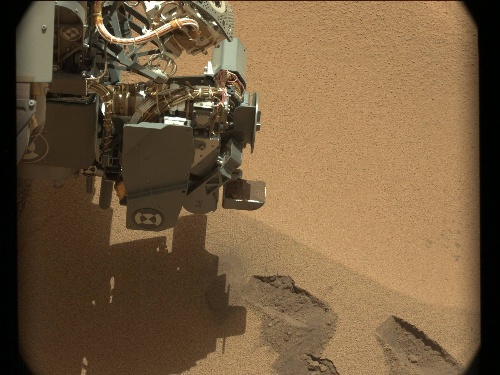 |
| A full bucket. Sol 93 left Mastcam eye (NASA/JPL/MSSS) |
Tuesday, November 6, 2012
Sol 90: A day of Change
 |
| A view of the NASA's Vehicle Assembly Building in Brevard county, Florida where spacecrafts are prepared for flights (NASA) |
Sol 90 also means that the mission team will now be following Earth time and not Mars time which is longer than ours by almost 40 minutes. Which means many won't have a constantly shifting reporting time to work with. And, as this article from the Pasadena Sun shows, some will have time to do some basic civilian stuff like ... voting!
So today really is a day for change! What a coincidence. Of course what happens at the polls today (on a serious note now) will ultimately affect the federal agencies (budgets especially) like NASA and their ability to do such wonderful things that inspire AND benefit us all here on Earth. There truly might never be another nation like America.
Friday, November 2, 2012
No methane. Now live with it!
Fascinating telecon today. The science tidbits were excellent and there was plenty of knowledge to go around. Members of the SAM instrument team were on today and their assessment was simple; no detection of methane has been made yet in all 4 cycles of SAM's 'Martian breathing' sessions. I'll post more on the instrument's details while summarising the initial findings of SAM, the first instrument of its kind to land on Mars, later.
But what struck me was the seemingly endless list of questions on the null results that came from the press. It's not there because it wasn't detected so further investigations are required. That's how science rolls now live with it! Its sort of like the patients you get around here; they get all worked up when you declare them fit but become almost jubilant when declared sick! Null results may be informative to scientific minds but they're just not good enough for publicity I guess!
But what struck me was the seemingly endless list of questions on the null results that came from the press. It's not there because it wasn't detected so further investigations are required. That's how science rolls now live with it! Its sort of like the patients you get around here; they get all worked up when you declare them fit but become almost jubilant when declared sick! Null results may be informative to scientific minds but they're just not good enough for publicity I guess!
CH4 or bust: Telecon today! UPDATED
NASA will host yet another telecon today to give an update on Curiosity mission's atmospheric research efforts. I think we all know what that means Methane (or CH4; that's its chemical formula showing 1 carbon atom and 4 hydrogen atoms) here we come!
Methane is an interesting molecule because one of its many sources besides volcanism is life! Concentrations of methane have been detected in the Martian atmosphere from space but Curiosity is the first mission that will make similar observations of the gas from the surface. But if I were betting my money, I'd say that life as a source is a no no. Probably its presence may signify still active volcanism on the Mars which would still make it an incredible find. We'll find out tonight at2000hrs 17000hrs GMT. You can listen in on today (11/02/2012) via ustream or NASA's audio feed.
Methane is an interesting molecule because one of its many sources besides volcanism is life! Concentrations of methane have been detected in the Martian atmosphere from space but Curiosity is the first mission that will make similar observations of the gas from the surface. But if I were betting my money, I'd say that life as a source is a no no. Probably its presence may signify still active volcanism on the Mars which would still make it an incredible find. We'll find out tonight at
We see you!
MAHLI or the Mars Hand Lens Imager at the end of the rover's arm turret has done it again, producing 55 high res images that have been stitched together to give some context of the rover's surroundings, with her as the primary subject!
That mountain behind her is Mount Sharp. It is kind of weird to see Curiosity framed in front of an extraterrestrial landform because many of us space enthusiasts never get to actually see images of the entire spacecraft sitting on the surface of another planet (let alone in such gorgeous resolution and colour). It's almost like actually being there. Or maybe the alien nature of the planet diminishes on seeing something familiar nearby so it helps to make Mars look more like some other desert on Earth (except for the sky).
If you look closely at Curiosity's cameras and ChemCam (the white box at the top of the mast with one big mirror to the right) you can see reflections of MAHLI! What fun! These images are a not a result of national vanity but will be used to assess dust accumulation on the vehicle and wear on the wheels (there are so many dents on those wheels now). Just to make it easier for my readers, you can access the full resolution version here. Emily over at the planetary society's blog has an educative (as usual) post on this image's projection here.
To top off this post, watch another of JPL's wacky video presentations of what its like be on Mars climate wise. Many of friends and relatives (those who agree to waste their time talking about another world that they might visit) assume that Mars is a rather warm if not hot place. It is anything BUT warm!
 |
| Curiosity enjoying the paparazzi! (NASA/JPL/MSSS) |
If you look closely at Curiosity's cameras and ChemCam (the white box at the top of the mast with one big mirror to the right) you can see reflections of MAHLI! What fun! These images are a not a result of national vanity but will be used to assess dust accumulation on the vehicle and wear on the wheels (there are so many dents on those wheels now). Just to make it easier for my readers, you can access the full resolution version here. Emily over at the planetary society's blog has an educative (as usual) post on this image's projection here.
To top off this post, watch another of JPL's wacky video presentations of what its like be on Mars climate wise. Many of friends and relatives (those who agree to waste their time talking about another world that they might visit) assume that Mars is a rather warm if not hot place. It is anything BUT warm!
Thursday, November 1, 2012
Innovation: the success story of CheMin
Yesterday's telecon helped to put into perspective the importance of what the Curiosity team has done; the first off-world spectroscopic analysis of extraterrestrial material using an X-ray diffraction instrument. And if that isn't enough, this instrument usually occupies a space equal to your average modern fridge! How do you lug such a thing to Mars? The only way out is to miniaturise it (my parents keep complaining about how the buttons on their phones keep getting smaller with every model. I don't hear them complaining now that there aren't anymore!).
CheMin's story is reminiscent of the progress computers have gone through over the past few decades ('a computer in every home?! You're crap' so they told Bill Gates). Miniaturisation is the endgame in technology and it demands innovation in design and even the way we think and consider reality. Now thanks to NASA's work, CheMin's spinoffs are available for a diverse number of uses including mining and HIV/AIDS virus research. In other words space pays off. Big time! (It is interesting to note that NASA does allow scientists to earn royalties from patented designs).
So how does it work? First we must remind ourselves some physics; X-ray is light in a manner of speaking. It is the second strongest 'light' in the electromagnetic spectrum. And like ordinary white light, it can undergo something called diffraction. This is the ability of a beam or a wave of any sort for that matter (like electromagnetic ones) to spread out when they pass through an aperture. Now when that happens to light (which is a mixture of wavelengths) the spread out waves give us the colours of the rainbow.
Now CheMin is all about diffraction. It actually takes 10mm cube of sample with 65mm cube in reserve in powdered form and puts this powder in the path of a laser beam. The beam, like the waves in the animation to the left of this passage, are spread out and the resulting image of the spread out waves (which we cannot see for obvious reasons) is recorded by a charged coupled device or CCD (another nifty gadget with NASA pedigree) which acts like an electric equivalent of our eyes' retina, recording the position as well as energy/frequncy of 99% of all the photons that strike it. It is a single-photon counting mode that ensures that a single pixel records a 1 or 0 value i.e. a photon or no photon. The X-rays are produced by a Cobalt source that is bombarded by electrons to excite it into emitting them. These rays are very energetic and anything producing or absorbing them needs to be cooled down to -60 degrees celsius. And that's important because they need to do these sessions for up to 10hrs (these can be divided up to save time and energy). Doing it at night also helps with the heating problem because its much colder then than during the day.
But hey! What's causing the X-ray beam to diffract? The powdery sample contains crystals with a maximum size of not more than 150microns. These crystals have regular crystal framework which acts like an aperture wonderland. The X-ray photons are spread out in a defined way which is dependent on the arrangement of the crystal's many atoms. It is this regular pattern of diffracting and interfering waves that allows scientists to know exactly what material they're handling and actually measure concentrations and ratios accurately for mineralogical identification (CheMin's CCD can also see the fluorescence (glow) that comes out of sample while it is being hit with X-rays allowing scientists to detect elements in the sample greater heavier than sodium in the periodic table).
And that is exactly what CheMin sent back to Earth:
The data can also be plotted by the counts (the number photons) against the energy of the photon although they didn't do so here. They detected feldspar, pyroxenes and olivine. The latter 2 make up most volcanic rocks. The speakers at the telecon compared the sample's signature to the volcanic material on the slopes of Mauna Kea in Hawaii although there is a signature showing that 50% is amorphous or non-crystalline material that doesn't seem to be easily explainable and they would have to do more research to find out what exactly is it. No water evidence (yet) if you having trouble following.
So that was pretty much that. The Q&A session saw a lot of queries on methane results from Curiosity. Project scientist John Grotzinger said he had nothing to say on that matter but said that it might be addressed next week (no people this ain't no conspiracy it's just that they're not yet ready for press).
The sample cells that hold the sample in the path of the X-ray number 27 which can be reused so for a mission that is set to last well beyond 2 years CheMin's future on Mars looks fairly secure for now. Five of them carry standard materials for calibration purposes including ceramics and quartz. The cells ride a wheel that can rotate 185 degrees to receive samples that's dropped from the funnels to the waiting cells. Each pair of connected cells vibrate to move the sample grains around so that all of them get a chance to say cheese for the X-ray beam with their best 'sides'. It is actually this vibration system that revolutionised CheMin because it allowed the powdered materials to be handled with very few moving parts.
I'll leave it here now with this video of the instrument's principal investigator Dr. David Blake giving a demo of CheMin. Stay curious now y'hear?
For the nerdy type, there plenty more to read about this instrument here.
 |
| Progress; from room size to the CheMin (circled in orange right above) and ultimately spinoffs for mining and research (yep, the orange case is it! ) (NASA/Ames/JPL-Caltech) |
So how does it work? First we must remind ourselves some physics; X-ray is light in a manner of speaking. It is the second strongest 'light' in the electromagnetic spectrum. And like ordinary white light, it can undergo something called diffraction. This is the ability of a beam or a wave of any sort for that matter (like electromagnetic ones) to spread out when they pass through an aperture. Now when that happens to light (which is a mixture of wavelengths) the spread out waves give us the colours of the rainbow.
 |
| Diffration (Commons) |
Now CheMin is all about diffraction. It actually takes 10mm cube of sample with 65mm cube in reserve in powdered form and puts this powder in the path of a laser beam. The beam, like the waves in the animation to the left of this passage, are spread out and the resulting image of the spread out waves (which we cannot see for obvious reasons) is recorded by a charged coupled device or CCD (another nifty gadget with NASA pedigree) which acts like an electric equivalent of our eyes' retina, recording the position as well as energy/frequncy of 99% of all the photons that strike it. It is a single-photon counting mode that ensures that a single pixel records a 1 or 0 value i.e. a photon or no photon. The X-rays are produced by a Cobalt source that is bombarded by electrons to excite it into emitting them. These rays are very energetic and anything producing or absorbing them needs to be cooled down to -60 degrees celsius. And that's important because they need to do these sessions for up to 10hrs (these can be divided up to save time and energy). Doing it at night also helps with the heating problem because its much colder then than during the day.
But hey! What's causing the X-ray beam to diffract? The powdery sample contains crystals with a maximum size of not more than 150microns. These crystals have regular crystal framework which acts like an aperture wonderland. The X-ray photons are spread out in a defined way which is dependent on the arrangement of the crystal's many atoms. It is this regular pattern of diffracting and interfering waves that allows scientists to know exactly what material they're handling and actually measure concentrations and ratios accurately for mineralogical identification (CheMin's CCD can also see the fluorescence (glow) that comes out of sample while it is being hit with X-rays allowing scientists to detect elements in the sample greater heavier than sodium in the periodic table).
And that is exactly what CheMin sent back to Earth:
 |
| The CheMin X-ray scattering pattern for Rocknest material (NASA/Ames/JPL-Caltech) |
So that was pretty much that. The Q&A session saw a lot of queries on methane results from Curiosity. Project scientist John Grotzinger said he had nothing to say on that matter but said that it might be addressed next week (no people this ain't no conspiracy it's just that they're not yet ready for press).
The sample cells that hold the sample in the path of the X-ray number 27 which can be reused so for a mission that is set to last well beyond 2 years CheMin's future on Mars looks fairly secure for now. Five of them carry standard materials for calibration purposes including ceramics and quartz. The cells ride a wheel that can rotate 185 degrees to receive samples that's dropped from the funnels to the waiting cells. Each pair of connected cells vibrate to move the sample grains around so that all of them get a chance to say cheese for the X-ray beam with their best 'sides'. It is actually this vibration system that revolutionised CheMin because it allowed the powdered materials to be handled with very few moving parts.
 |
| CheMin's pair of cells (NASA/Ames/JPL) |
For the nerdy type, there plenty more to read about this instrument here.
Monday, October 29, 2012
Reminder about Tuesday's telecon
Just reminding myself and anyone else that there will be a teleconference for an update on Curiosity's status. You can listen in on Tuesday (10/30/2012) via ustream or NASA's audio feed. The conference will start at 1830 hrs GMT.
Saturday, October 27, 2012
JPL Curiosity video update: Zapping Stonehenge
I always enjoy the Jet Propulsion Lab's video presentations. This one was posted on Youtube just yesterday and provides a good update on what the ChemCam instrument has been doing this past few days including zapping an unusual feature dubbed 'Stonehenge' (because it looks similar to the ancient monument in England) with its laser. But why is it like that? Play the video to find out!
Also there will be yet another telecon on Tuesday (October 30) next week at 1830 hrs GMT.
UPDATE: I found the image taken by Curiosity's scientific camera (left eye Mastcam) of the interesting feature mentioned above. It was taken on sol 72 or about 9 days ago as of this writing:
Also there will be yet another telecon on Tuesday (October 30) next week at 1830 hrs GMT.
UPDATE: I found the image taken by Curiosity's scientific camera (left eye Mastcam) of the interesting feature mentioned above. It was taken on sol 72 or about 9 days ago as of this writing:
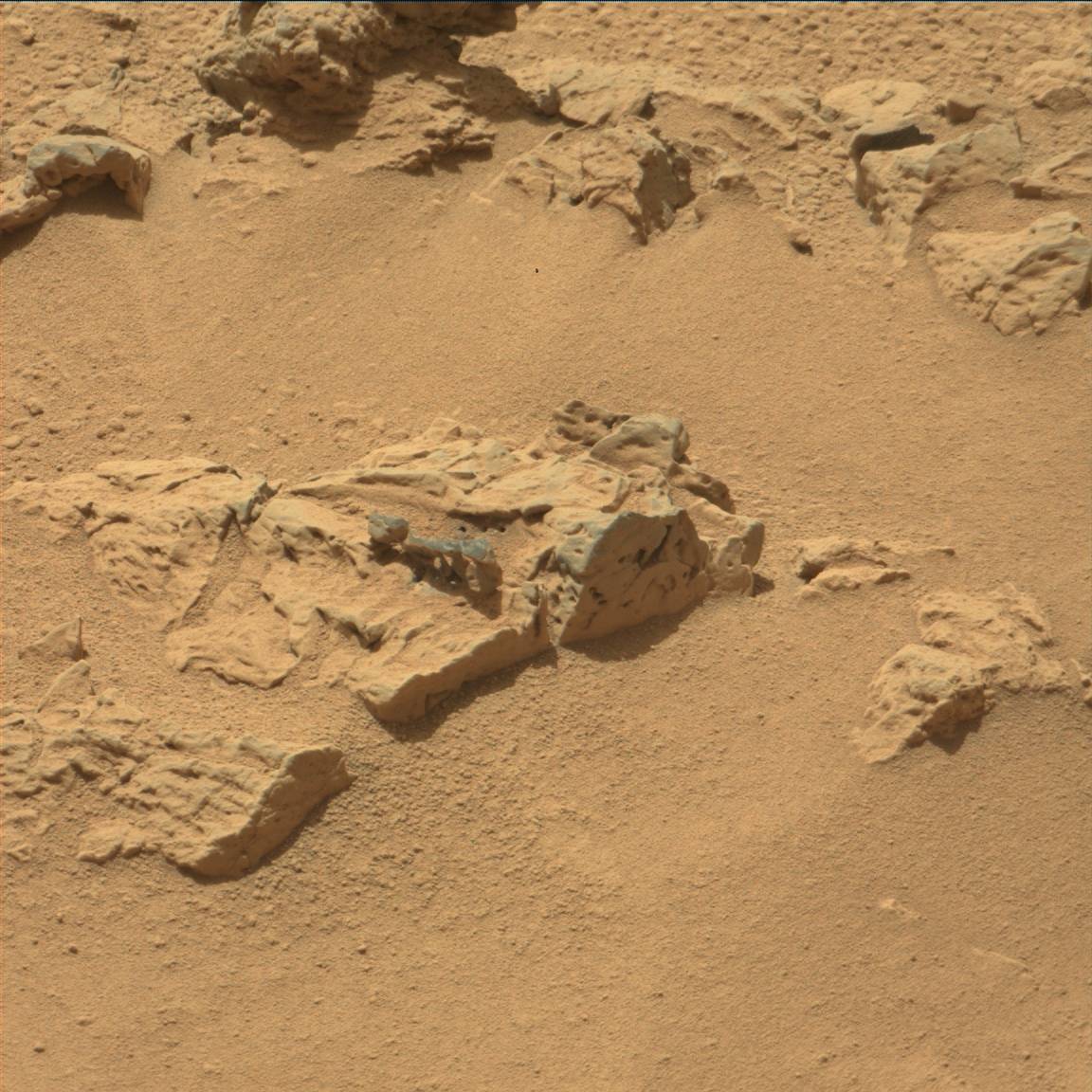 |
| (NASA/JPL/MSSS) |
Thursday, October 25, 2012
Zapping away at Rocknest
I noticed subframe colour images coming down from the 100mm Mastcam so I decided to take a break from reading internal medicine and stitching them up. The results:
What we're seeing here is the cluster of volcanic rocks (most likely vesicular basalt because it looks 'bubbly' attesting to the gases it once held when it was still molten rock) aptly named 'Rocknest'. Notice the drifts of sand around them. They act as a sort of wind breaker and any dust/light aeolian material is dropped off around them. The drift that Curiosity is investigating right now stems from these rocks influencing their environment.
The ChemCam instrument is also being used to investigate these rocks. We can see the results of yesterday's 'shootings' in the image returned below:
 |
| True colour mosaic of 'Rocknest' sol 76 (NASA/JPL/MSSS/mosaic by me) |
The ChemCam instrument is also being used to investigate these rocks. We can see the results of yesterday's 'shootings' in the image returned below:
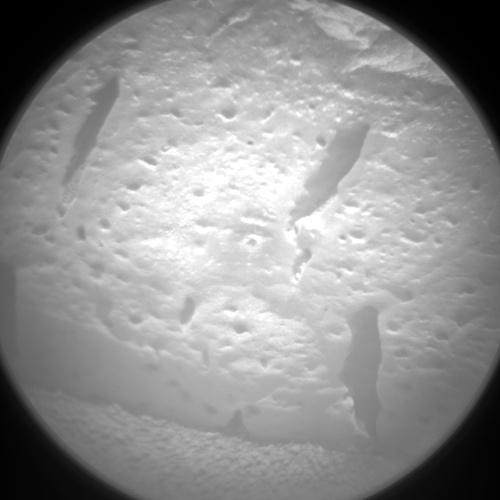 |
| The small bullseye in the middle is in the order of microns in diameter (NASA/JPL/LANL) |
Wednesday, October 24, 2012
Secrets of the dirt
It's now sol 77 at Curiosity's site and I see there has been another dig as well as another sample for the observation tray processed by CHIMRA! This past week has been all about dirt although Curiosity does deal with other measurements while doing all these things that we talk about here on the blog; monitoring the environment, remote sensing et cetera. All that demands wise scheduling to avoid becoming power deficient (while Curiosity uses nuclear power, it's not a direct supply as the battery has to be topped up before the rover has access to the power) and to edit out science activities (a delicate matter for the surface operations manager)!
Anyway, what interested me before this fourth dig took place were the fascinating images of the observation tray holding the sample from the third dig taken by MAHLI.
Here is another image of the tray viewed up close by MAHLI.
You can see here that there are at least 3 kinds of particles in the image above. The biggest are the white ones and then there are the slightly smaller, grey or black coloured ones and finally the ubiquitous fine Martian dust which prefers to stick in clumps rather than hang around alone. This means it is cohesive. Notice also how asymmetric the sample in terms of the way the grains are arranged in relation to all other grains in addition to the size with finer grains located a little farther away than the rest of the rest of the (presumably heavier) grains. It could indicate the wind direction at the time
There was another image that was part of shown the recent mission site report that showed the results of ChemCam's lazing of the sandy material on the drift with its powerful laser on sol 74.
Reading Ken Herkenhoff's incredible insider blog, we get the reason why they did this particular drift:
The dirt certainly holds many secrets. I don't about rest of you but pedology (the study of soils) rocks! Especially if it's out of this world!
| Kind of reminds you of a kid playing with a toy shovel! Sol 74 navigation image (NASA/JPL) |
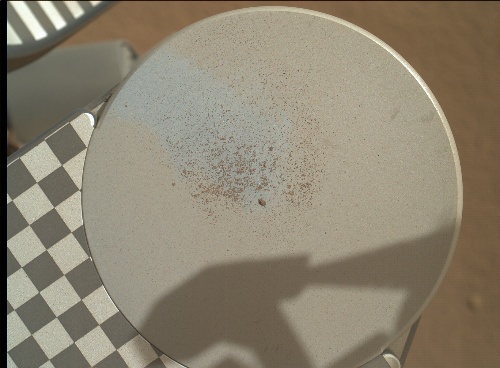 |
| MAHLI view of the tray, sol 73 (NASA/JPL/MSSS) |
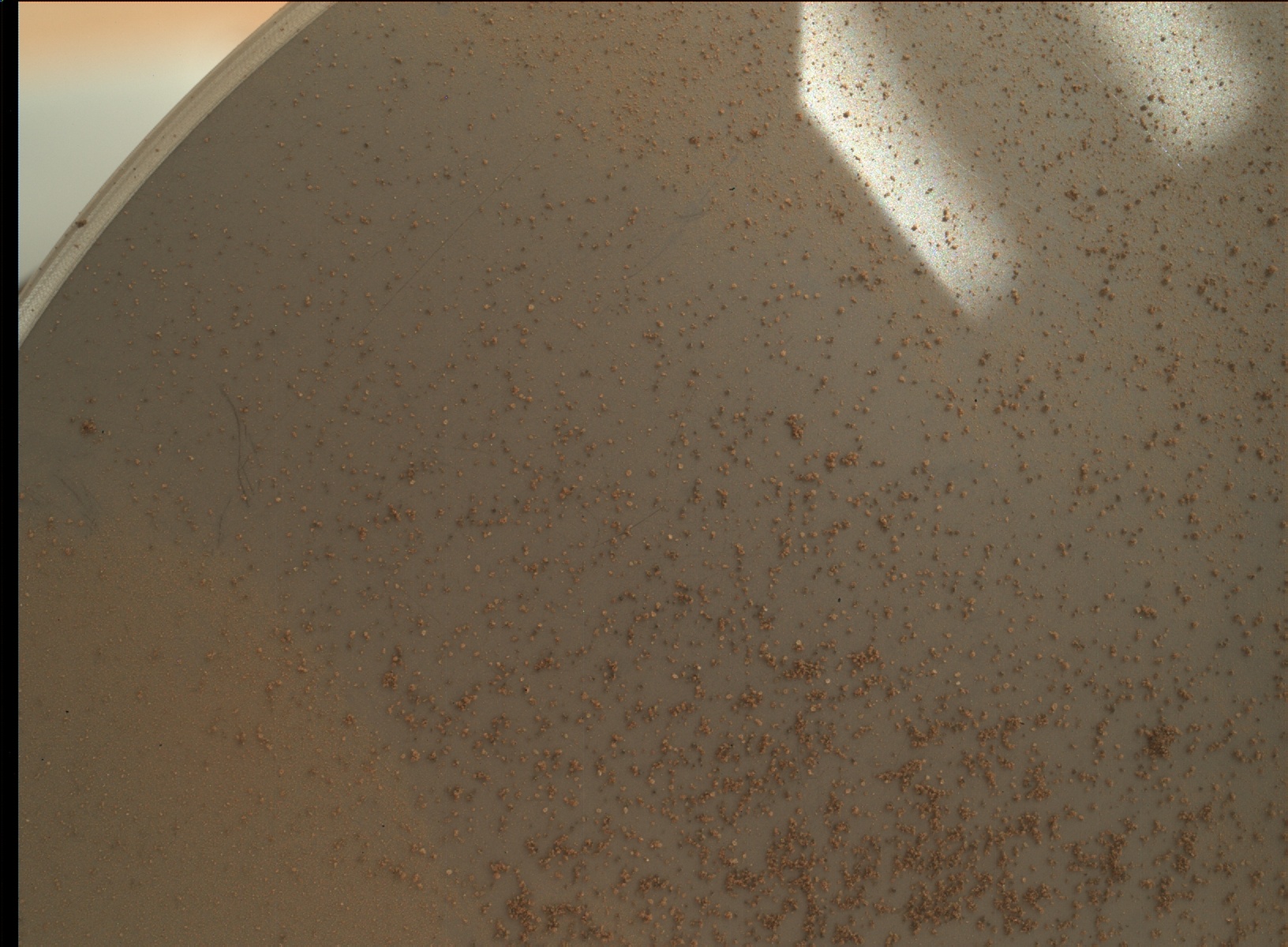 |
| Observation tray by MAHLI (NASA/JPL/MSSS) |
There was another image that was part of shown the recent mission site report that showed the results of ChemCam's lazing of the sandy material on the drift with its powerful laser on sol 74.
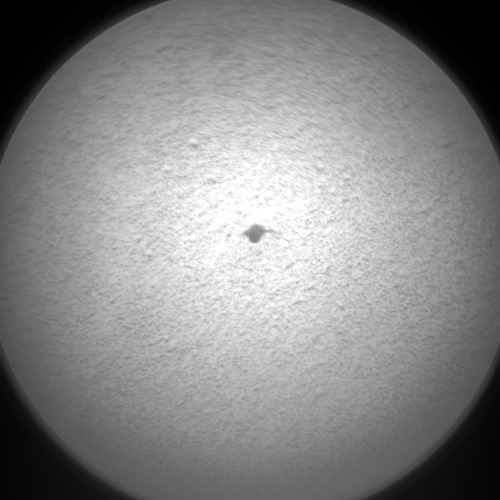 |
| ChemCam's zaps the target (NASA/JPL/LANL) |
In addition to the long-planned arm activities (4th scoop of soil), we added MAHLI images of the far side of the ripple we are scooping, Mastcam mosaics, and ChemCam LIBS observations of a nearby patch of soil during the day and just before dawn. The ChemCam observations are intended to see whether water frost forms on the surface during the night, by comparing the amount of hydrogen seen in the LIBS spectra when the soil is warm and cold.Which would also help to explain why they were taking these images of drifts when the sun was low in the sky.
| Sol 74 navigation image (NASA/JPL) |
Thursday, October 18, 2012
CheMin has received sample!
Yet another milestone for this mission; the speakers at today's telecon announced that they have received confirmation that the chemistry and mineralogy instrument has received a portion of the third sample. They haven't given SAM any yet because 'it isn't ready yet' so they'll do all of this again when they're ready.
Concerning the sparkling bits I talked about recently, apart from the hunch that these particles are probably native to Mars and therefore not a threat to Curiosity's analysis (which is why they the second dig took a little longer while they mulled over the matter) they haven't much more about what they are. They gave probable reasons for their anomalous appearance including the mineralogical ones (cleavage, refracting light and all other sorts of geological grammar).
They gave a good talk about what they see in the sample that's already on the tray. They noted that there are 2 kinds of particles based on size. The coarser type are darker compared to the finer ones which are so light that they allow most of the tray's reflected light to pass through unimpeded, giving them a much lighter appearance compared to when they were still in the drift.
They mentioned importantly that this all means that we have 3 size-classes of particles here, large particles (in the range of millimetres) which sort of armour the drifts of finer material, preventing them from moving with the wind as they are simply too heavy for Mars' low density air to move. Below this armour there is the finer particles that are (I think) the coarse, dark-coloured particles that we see on the tray. Anything finer is probably dust. All finer components are at or below 150 micron level and they are light enough to be lifted up by winds. Enough to evenly distribute them across the planet. So by analyzing them, we can learn a lot about global Martian dust and drift material because these samples are representative of the whole of Mars rather than local (which would include things that can't be moved very far like the coarse armour material).
Chemical analyses of Martian materials isn't all that special but CheMin is important because it can actually analyse the mineralogical makeup of samples which is unprecedented in Mars exploration!
It's now 6: 30am on sol 72 of Curiosity's mission at Gale crater. Stay tuned!
Concerning the sparkling bits I talked about recently, apart from the hunch that these particles are probably native to Mars and therefore not a threat to Curiosity's analysis (which is why they the second dig took a little longer while they mulled over the matter) they haven't much more about what they are. They gave probable reasons for their anomalous appearance including the mineralogical ones (cleavage, refracting light and all other sorts of geological grammar).
They gave a good talk about what they see in the sample that's already on the tray. They noted that there are 2 kinds of particles based on size. The coarser type are darker compared to the finer ones which are so light that they allow most of the tray's reflected light to pass through unimpeded, giving them a much lighter appearance compared to when they were still in the drift.
 |
| Mastcam image of the sample on the tray (NASA/JPL/MSSS) |
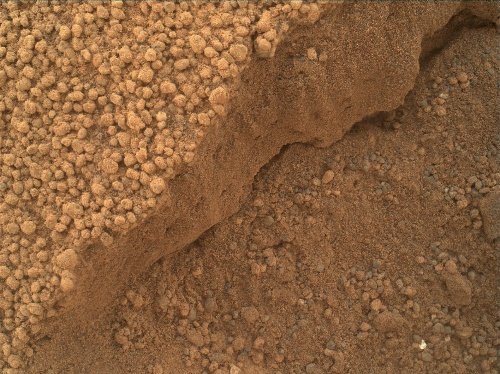 |
| Sol 67 MAHLI image of the second dig. Notice the top, coarser armour layer and the finer material below (NASA/JPL/MSSS) |
It's now 6: 30am on sol 72 of Curiosity's mission at Gale crater. Stay tuned!
Wednesday, October 17, 2012
First use of the observation tray
Sol 69 images show a successful dig at a third site at the 'Rocknest' drift.
There aren't as many images coming down (apart from the less memory-hungry thumbnail images sent as previews) because the rover's main high data-rate relay, the Mars Reconnaissance Orbiter (MRO) has suffered a glitch and has gone into safe-mode where only the most basic of spacecraft functions are running. So that means the rover has to make use of the older orbiter, Mars Odyssey, for data relay. And as you can imagine it's not all that fast.
Looking at the images of the scooped up sample, you can see they have managed to grab a bit of the sparkling stuff that has been puzzling the team for some time (previously it was a question of whether it was native to Mars or a piece of rover hardware) and will probably analyse it with SAM and CheMin.
Images from sol 70 show that they are actually making use of the rover's observation tray which can receive material processed by CHIMRA for detailed analysis by the APXS and MAHLI instruments on the rover's arm. Again these are only sub-frame images due to communication constraints.
We may hear more about at tomorrow's teleconference. It's now 7:39am, sol 71 at Curiosity's site on Mars. Stay tuned!
| Sol 69 navigation images now show 3 trenches (NASA/JPL) |
Looking at the images of the scooped up sample, you can see they have managed to grab a bit of the sparkling stuff that has been puzzling the team for some time (previously it was a question of whether it was native to Mars or a piece of rover hardware) and will probably analyse it with SAM and CheMin.
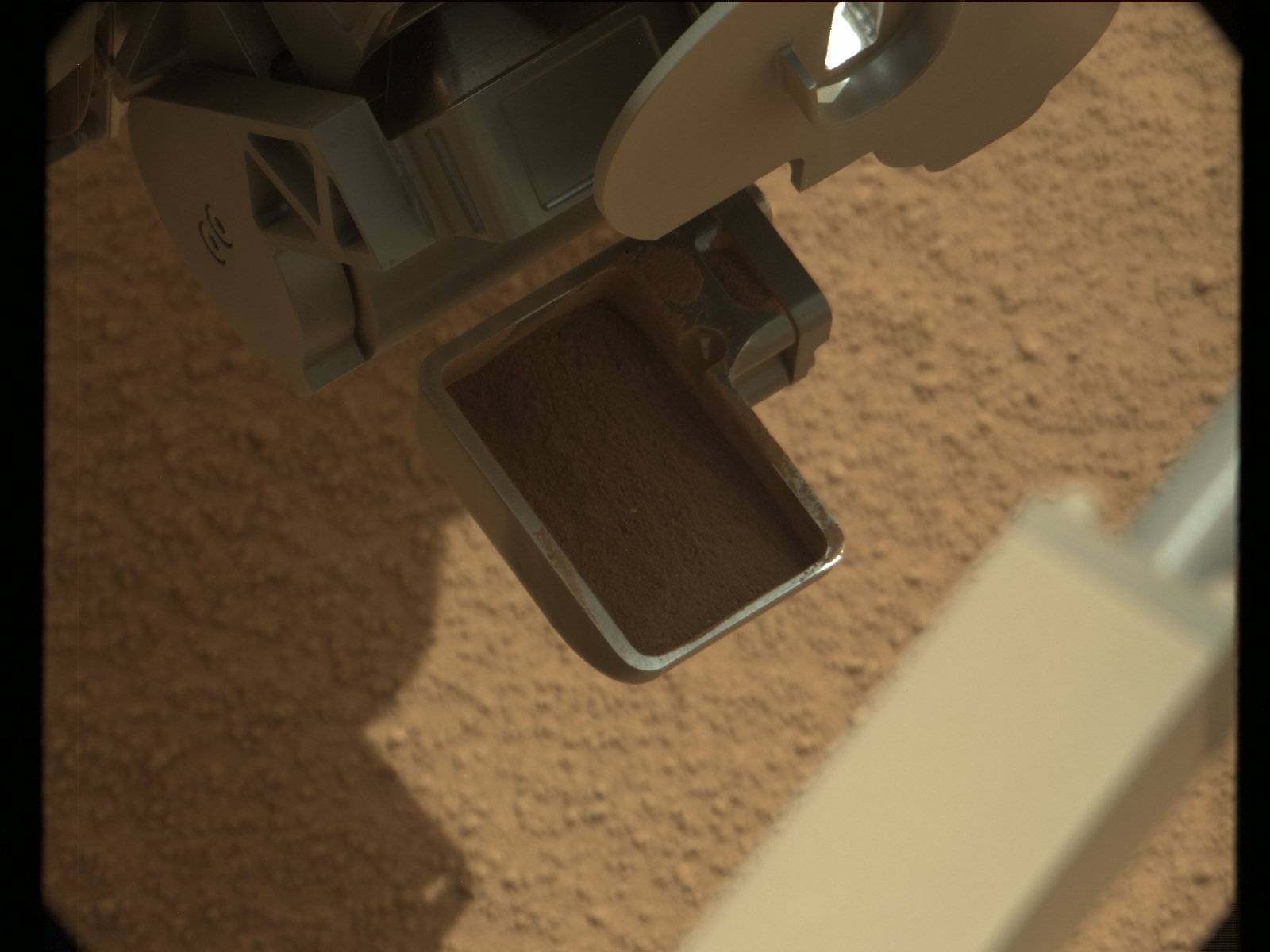 |
| Mastcam image from Sol 69 (NASA/JPL/MSSS) |
| Observation tray with sample, sol 70 navigation image. The b/w squares are for probably for length calibration during imaging. |
We may hear more about at tomorrow's teleconference. It's now 7:39am, sol 71 at Curiosity's site on Mars. Stay tuned!
Teleconference for Oct 18
There will be a telecon tomorrow at 1900 hrs GMT. There are indications that this one will be an update on methane (natural gas) gas detection by the rover which is actually one of its objectives. Methane is produced by two things that we know of on Earth at least; volcanic activity and life. The gas has been monitored in the Martian atmosphere for the past few years by orbiters but Curiosity will be the first to monitor the gas from the surface. What does the gas indicate? Maybe life, maybe still rumbling volcanoes on what is supposed to be a practically geologically dead planet. The rover team hopes to contribute data on the question. We'll see it all tomorrow! You can listen in via NASA's audio feed.
Now if you'll excuse me, I'm off to find a place to quietly contemplate the discovery of an earth-sized mass planet that has just been discovered orbiting Alpha-Centauri B, one of the nearest star systems to our solar system (only 4.5 light years away). We live in exciting times! Stay curious.
[Read the press release and paper about this EXTRAORDINARY discovery on nature's site]
Now if you'll excuse me, I'm off to find a place to quietly contemplate the discovery of an earth-
[Read the press release and paper about this EXTRAORDINARY discovery on nature's site]
Tuesday, October 16, 2012
Sparkling bits in the dirt
Curiosity has finished its second scoop and dump procedure and should have completed the third and final scoop and dump by now. After that we should see some interesting science being done soon with the delivery of the mission's first sample to CheMin and SAM. But there is interesting news about something in the soil that's being done. From yesterday's press bulletin on the mission's website:
Here is MAHLI's image of the largest white particle.
I haven't a clue what it is and that my friends is the beauty of scientific inquiry; ignorance combined with the will to learn. And we're here to learn about Mars' natural history! Stay tuned.
The rover's second scoopful, collected on Sol 66 (Oct. 12), was intentionally discarded on Sol 67 due to concern about particles of bright material seen in the hole dug by the scooping. Other small pieces of bright material in the Rocknest area have been assessed as debris from the spacecraft. The science team did not want to put spacecraft material into the rover's sample-processing mechanisms. Confidence for going ahead with the third scooping was based on new assessment that other bright particles in the area are native Martian material. One factor in that consideration is seeing some bright particles embedded in clods of Martian soil. Further investigations of the bright particles are planned, including some imaging in the Sol 69 plan.These white sparkly things didn't really stand out as a piece of spacecraft material would but you can definitely see them even without MAHLI.
 |
| Sol 67 MastCam shot. The most prominent white particle is highlighted (NASA/JPL/MSSS) |
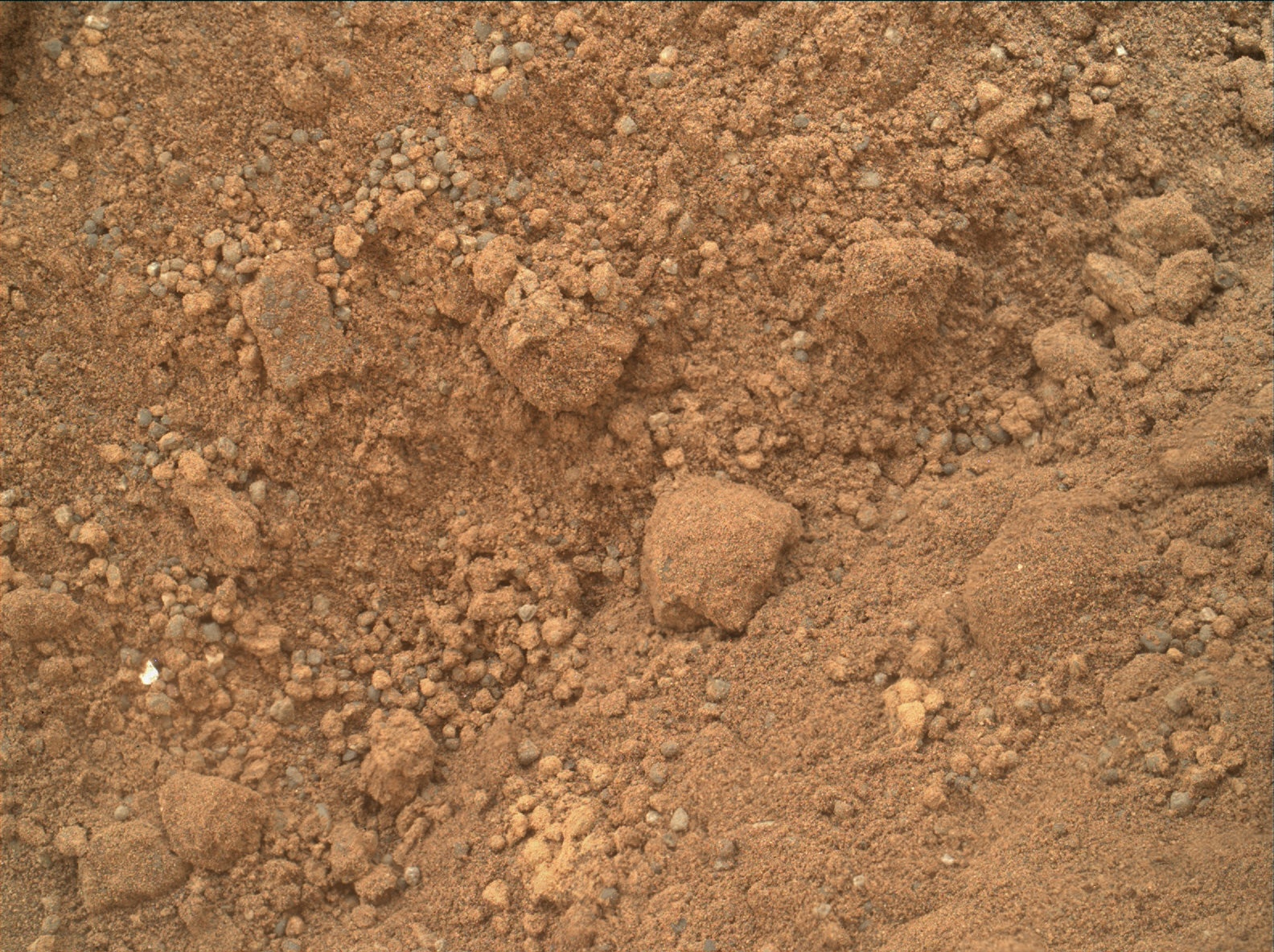 |
| Sol 67 MAHLI shot; the particle is located near the lower left corner (NASA/JPL/MSSS) |


